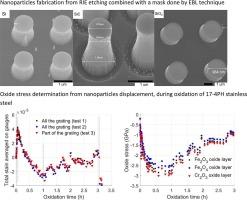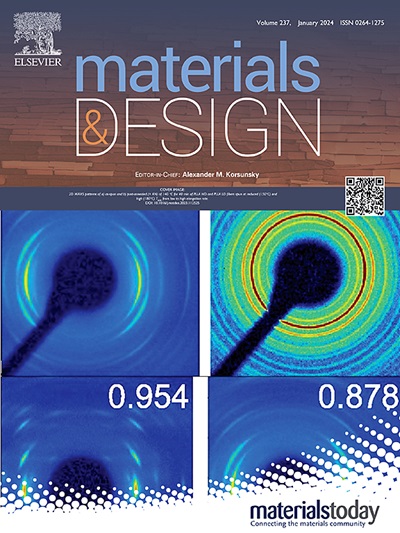用于监测金属高温氧化过程中表面机械状态的微纳灼烧器设计--应用于 17-4PH 不锈钢
IF 7.6
2区 材料科学
Q1 MATERIALS SCIENCE, MULTIDISCIPLINARY
引用次数: 0
摘要
在高温氧化过程中确定热氧化物生长的机械状态是一项挑战。目前正在研究制作用于监测高温氧化过程的纳米规,最高温度可达 1000 ℃。对几种材料的机械性能和最高工作温度进行了测试,以确定在空气中热加载期间用作标记的量规。通过实验确定了适用于高温氧化的优化检具材料。二氧化硅为测定金属/氧化物系统机械状态的量规提供了特别有趣的特性。本文还特别关注了两种纳米制造工艺及其局限性。标准电子束光刻工艺非常适合制造氧化应用的量规,并可通过使用反应离子蚀刻工艺加以改进。量规最终可以达到几微米的高度,这样在热加载过程中氧化层就不会覆盖量规,从而可以在短时间内进行相关监测。为了说明这一点,提出了在 480 °C 氧化的 17-4PH 不锈钢中的应用,并推导出了应力动力学,将其与先进的热机械化学模型联系起来,同时确定了与生长或松弛机制相关的不同热机械化学参数的数值。本文章由计算机程序翻译,如有差异,请以英文原文为准。

Micro-nanojauges design to monitor surface mechanical state during high temperature oxidation of metals with application to 17-4PH stainless steel
Determination of mechanical state of thermal oxide growing during high temperature oxidation is a challenge. Fabrication of nanogauges for monitoring during high temperature oxidation was presently investigated up to 1000 °C. Several materials were tested in terms of mechanical behaviour and maximum working temperature for gauges used as markers during thermal loading under air. The experimental determination of the optimized gauges material for high temperature oxidation was validated. SiO2 offers particularly interesting features for gauges to determine the mechanical state of metal/oxide system. In this article, a special attention has also been paid to two nano-fabrication processes, as well as their limits. The standard electron beam lithography process is well suited to build gauges for oxidation applications, and can be improved by use of reactive ion etching process. The gauges can eventually reach several micrometers height such that the oxidation layer does not cover the gauges during thermal loading for relevant monitoring at short oxidation times. To illustrate, an application to a 17-4PH stainless steel oxidized at 480 °C is proposed and stress kinetics are deduced and related to an advanced thermomechano-chemical model, as well as identification of the numerical values of different thermomechano-chemical parameters associated to mechanisms of growth or relaxation.
求助全文
通过发布文献求助,成功后即可免费获取论文全文。
去求助
来源期刊

Materials & Design
Engineering-Mechanical Engineering
CiteScore
14.30
自引率
7.10%
发文量
1028
审稿时长
85 days
期刊介绍:
Materials and Design is a multi-disciplinary journal that publishes original research reports, review articles, and express communications. The journal focuses on studying the structure and properties of inorganic and organic materials, advancements in synthesis, processing, characterization, and testing, the design of materials and engineering systems, and their applications in technology. It aims to bring together various aspects of materials science, engineering, physics, and chemistry.
The journal explores themes ranging from materials to design and aims to reveal the connections between natural and artificial materials, as well as experiment and modeling. Manuscripts submitted to Materials and Design should contain elements of discovery and surprise, as they often contribute new insights into the architecture and function of matter.
 求助内容:
求助内容: 应助结果提醒方式:
应助结果提醒方式:


